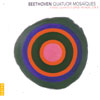Beethoven String Quartets, Op 18, Nos 2 & 3
One outburst aside, this foursome tend to be dogged in Beethoven
View record and artist detailsRecord and Artist Details
Composer or Director: Ludwig van Beethoven
Genre:
Chamber
Label: Astrée Naïve
Magazine Review Date: 8/2007
Media Format: CD or Download
Media Runtime: 52
Mastering:
Stereo
DDD
Catalogue Number: E8902

Tracks:
| Composition | Artist Credit |
|---|---|
| String Quartet No. 2 |
Ludwig van Beethoven, Composer
Ludwig van Beethoven, Composer Mosaïques Quartet |
| String Quartet No. 3 |
Ludwig van Beethoven, Composer
Ludwig van Beethoven, Composer Mosaïques Quartet |
Author: Nalen Anthoni
How you respond to these interpretations will depend on how you respond to the playing style of the Mosaïques Quartet. Theirs is a mildly insistent, lumbering gait that is perhaps a corporate reflection of Erich Höbarth’s weighty mode of expression. But when modified to suit the music, eg Haydn’s Op 64 Nos 2, 4 & 5 (10/02), the results are of a richly inflected potency – which is not always repeated here.
Sample the first movements of both quartets. The opening bars are lyrically expounded, that of No 3 matching Basil Lam’s description “exquisitely poetic”; but in both cases the Mosaïques offer little variety to their full tone and subdue the lean drive that also characterises the music. It is a single-minded view, of a corpulent comfort that also spills into the Adagio cantabile slow movement of No 2 where a loosely held middle Allegro doesn’t offer enough contrast.
But there is a much less inhibited side to their approach too. Get past the Scherzo of No 2, short on incisive lightness, to find a performance of the finale that is the antithesis of what’s gone before. The Mosaïques here break away from the constraints of the bar-line and allow the rhythm to flow freely. The result is a forward-moving exuberance that is as unexpected as it is welcome. The slow movement of No 3 also benefits from a similar flow but studied doggedness returns to afflict the remaining movements. Good sound but transfer levels are too high.
Sample the first movements of both quartets. The opening bars are lyrically expounded, that of No 3 matching Basil Lam’s description “exquisitely poetic”; but in both cases the Mosaïques offer little variety to their full tone and subdue the lean drive that also characterises the music. It is a single-minded view, of a corpulent comfort that also spills into the Adagio cantabile slow movement of No 2 where a loosely held middle Allegro doesn’t offer enough contrast.
But there is a much less inhibited side to their approach too. Get past the Scherzo of No 2, short on incisive lightness, to find a performance of the finale that is the antithesis of what’s gone before. The Mosaïques here break away from the constraints of the bar-line and allow the rhythm to flow freely. The result is a forward-moving exuberance that is as unexpected as it is welcome. The slow movement of No 3 also benefits from a similar flow but studied doggedness returns to afflict the remaining movements. Good sound but transfer levels are too high.
Discover the world's largest classical music catalogue with Presto Music.

Gramophone Digital Club
- Digital Edition
- Digital Archive
- Reviews Database
- Full website access
From £8.75 / month
Subscribe
Gramophone Full Club
- Print Edition
- Digital Edition
- Digital Archive
- Reviews Database
- Full website access
From £11.00 / month
Subscribe
If you are a library, university or other organisation that would be interested in an institutional subscription to Gramophone please click here for further information.




